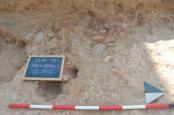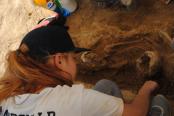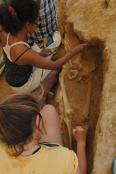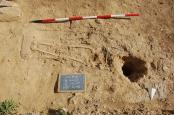CAMPAGNA 2015 |
1° SETTIMANA |
2° SETTIMANA |
3° SETTIMANA |
4° SETTIMANA |
5° SETTIMANA |
6° SETTIMANA |
08 LUGLIO 2015 
Resoconto della giornata di scavo
Area 2000
Introduzione all'Area di scavo 2000.
Lo scavo dei Settori B dell’Area 1000 e 2000 ha permesso di constatare le differenze dal punto di vista organizzativo, per ciò che riguarda l’impostazione generale, tra il cimitero medievale e quello settecentesco/ottocentesco. Le sepolture medievali raramente si intercettano tra loro, sono orientate Est Ovest con forma regolare ellissoidale, e risultano allineate tra loro; inoltre, gli individui che venivano deposti non possedevano oggetti di corredo, se non, in alcuni casi, oggetti legati all’aspetto prettamente religioso. Dalle osservazioni tafonomiche è stato rilevato che spesso venivano indossati sudari o vesti al momento della deposizione. Al contrario, le sepolture delle ultime fasi d’uso del cimitero non seguono norme precise e il poco spazio a disposizione veniva utilizzato in maniera intensiva, un dato che è stato confermato archeologicamente dal fatto che molte delle fosse sepolcrali più antiche venivano intercettate da quelle più recenti senza seguire un orientamento unico. In molte occasioni sono stati documentati ossari o riduzioni che confermano l’intento di rispettare i corpi disturbati seppellendoli all’interno dell’area considerata sacra.
Queste osservazioni sono state effettuate dopo aver documentato altre due sepolture medievali:
US-2597 al centro del settore B, all’interno della trincea, è un taglio sepolcrale ellissoidale orientato canonicamente Ovest Est per la deposizione di Usk 2598 che è stato documentato e rimosso. L’individuo, malamente preservato, è un adulto, probabilmente di sesso maschile, con la testa in norma laterale sinistra e posta ad Ovest, gli arti superiori asimmetrici (il sinistro flesso sul bacino, il destro disteso lungo il fianco), e gli arti inferiori distesi paralleli e ravvicinati; gli aspetti tafonomici fanno pensare alla presenza di un sudario al momento della deposizione.
US-2581 è anch’esso un taglio regolare ellissoidale, con medesimo orientamento, collocato nell’angolo Sud Occidentale del Settore B dell’Area 1000. La rimozione del riempimento ha garantito l’individuazione e la parziale messa in luce di Usk 2600 che sarà completata domani; esso è in buono stato di conservazione ma non sembra essere conservato il cranio che è stato tagliato ad Ovest da una delle fosse indagate lo scorso anno. Nell’allargamento Ovest è stata completata la messa in luce della riduzione US 2596 posta al di sopra dell’individuo USk 2577; domani si procederà alla completa documentazione e rimozione di entrambi.
Our group began today by starting to remove the fill surrounding 2582, exposing a medieval burial which is located against the wall of the church in sector B. We then continued to the reveal 2577 which is located in the western expansion of the area, also the group continued to reveal and eventually remove usk 2598 which was located within the trench of area B. We finished excavating 2594 and finally removed the bones and completed the required paperwork. The medieval burial, usk 2598, located within the tench in sector B was systematically further exposed, photographed, documented, and removed.
It is notable that there are distinct burial behaviors in the graves among all of area 2000. The medieval burials were conducted with a much more systematic consistency and intention in that they have similarly shaped grave cuts, are spaced individually, and are all oriented West/East. On the other hand, the more recent burials, dating to the 19th century, are more of a jumble in which, even for the cholera burials, the grave cuts cut other previous burials, whether fresh or not. The distinctions are not as clear in the shape and placement of each individual.
Area 3000
Nella porzione sud-occidentale del Settore B sono stati messi in luce e successivamente rimossi gli individui adulti USK 3579 e USK 3587, entrambi orientati S-N e deposti supini rispettivamente all’interno delle fosse sepolcrali UUSS – 3577 e – 3421. In particolare di USK 3579 si conserva solamente il torace, il bacino e parte del femore sinistro, mentre di USK 3587 rimane l’arto inferiore destro e parte del coxale corrispondente, mentre il resto del corpo è stato intercettato ed asportato da una canaletta di epoca moderna. Nella porzione orientale del Settore, lungo la sezione meridionale della trincea US – 3386 è in corso lo scavo dell’inumato USK 3588, orientato W-E e deposto in decubito dorsale all’interno di US – 3569; la tomba in questione ha probabilmente intercettato una sepoltura precedente, di cui rimane solamente parte del coxale sinistro e dell’arto inferiore dello stesso lato. Durante la messa in luce di USK 3588 sono state individuate alcune ossa di un individuo infantile, la cui eventuale connessione anatomica deve essere ancora chiarita. Più a nord, lungo la sezione nord-orientale della stessa trincea è iniziata la messa in evidenza di un altro scheletro, anch’esso orientato W-E, che sembra essere stato in parte tagliato da ciò che sembra essere una vera e propria fornace a camera circolare, i cui limiti e la sua reale funzione saranno approfonditi nei giorni seguenti.
In the northern half of area 3000/B the “oven” pit discovered yesterday was further outlined and the grave cut to the east of the pit was identified and excavated. Partially articulated remains of USK 3564 were discovered. The grave included articulated skeletal remain beginning with the thorax: Right ribs, Right scapula, right radius and ulna, partial vertebral column, and fully articulated lower body. In the fill of USK3564, numbered US3563, metal slags and fragmentary burned bone. From the excavation of the burial the “oven “ pit was identified as intercepting the burial meaning the oven was created after the burial. In the southern half of area 3000/B, USK 3587 was removed. Only the femur, patella, tibia, fibula, part of the os coccyx, and two tarsals remained. The grave was cut when the trench in the western portion of area 3000 was created, removing the rest of the skeleton. A pin from a shroud and a piece of pottery was found in the fill of the grave. USK 3579 was finished and completely removed. The grave cut was elongated and was cut by the most southern part of the wall in section B. In the southern section of sector B, near the trench, we continued to excavate a grave containing multiple individuals, including a juvenile. We exposed a fully articulated skeleton with its arms crossed over its pelvis that is underneath many other individuals. Tomorrow we will continue to expose and document this individual.
Area 5000
Dopo aver ripulito nuovamente la porzione occidentale dell'area, siamo riusciti a identificare e documentare tutte le evidenze stratigrafiche che emergono. Le più significative tra questi nuovi strati sono US 5188, una chiazza molto sottile formata dal disfacimento di numerosi laterizi sottostanti che compongono i riempimenti di due distinte buche: US 5202 e US 5205. Queste tagliano il piano di vita caratterizzato dalla presenza di frammenti di malta in disfacimento US 5187. Verso Sud è stata rinvenuta e scavata invece una nuova buca, di piccole dimensioni (circa 15 cm di diametro) probabilmente relativa alla messa in opera di un piccolo sostegno ligneo. Nei prossimi giorni scaveremo tutti i nuovi tagli emersi così da avere maggiori informazioni riguardo una datazione assoluta più precisa e puntuale.
Today in area 5000 we began in two groups, the first worked on excavating the red-clay trench in the South-Western corner of the area. While the second group worked on a number of features in the North-West. The red-clay trench proved to be rather deep, extending roughly 40cm before hitting sterile soil. The trench was filled with red-clay, mortar, and rocks. In digging the trench we created artificial squared edges thus allowing us to examine the strata of the site. Meanwhile, the North-West area continued delineating US 5192, the hole with the red bricks from the previous day. We began by scrapping away the red sediment to expose a brown layer. A photograph was taken before we began to remove the brown layer to better expose two fills of brick and rock to the west of US 5192. The southernmost was labelled US 5204 while the other is US 5205. Once this task was completed, another photograph was taken. We only were just able to start removing the fill from US 5205 before the day’s end.
Area 6000
Nella giornata odierna è iniziata la rimozione della riduzione US 6024 relativa alla sepoltura USk6023, nella porzione nord orientale del settore B dell'area. Per quanto riguarda il settore A, sul suo limite settentrionale è stato messo in luce il taglio US -6027 tramite la rimozione del riempimento US 6028. Questa attività potrebbe essere relativa ad una fase cimiteriale intercettata, ai primi del XX sec., dalla trincea di drenaggio US -6007. Per quanto riguarda la restante superficie del settore A, è iniziata la rimozione dello strato superficiale US 6029, caratterizzato dalla presenza di numerosi frammenti ossei nella tessitura del deposito. Tale rimozione sta permettendo di mettere in evidenza il filo settentrionale della struttura USM 6004, il muro con andamento est-ovest che pare relazionarsi con il cantonale sud-occidentale della facciata originaria della chiesa di San Pietro.
Today we started off our excavation troweling through the cut we worked on yesterday afternoon. We found the bottom of the cut, and finally we pick-axed area 6029 to level out the region we were working on. Our intent of this process was to find its position around the exposed wall to the north as well as any hidden stones to indicate more of the church’s wall. Dozens of one of the context’s bone fragments were found, as well as two nails, and a couple 14th century pottery pieces.
We also worked on the skeleton in area 6024 and filled out our first skeletal context sheet for our area. Today we actually removed all of the reduction pieces and began clearing away more fill around the bones in order to actually remove the bones individually from the burial. Tomorrow we will finish removing bones from the burial and hopefully remove another level, as we believe there is another burial underneath the one we are working on currently.
In addition with the other area being worked on, we also completed area 6028 by removing the fill. Unfortunately, not much was found in this area, but we hypothesized that it was possibly a burial before the cut was made for the trench. Later on, most likely during the fourth week of excavation we plan on continuing to excavate area 6003.














